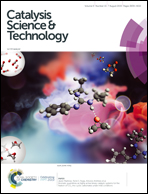Highly selective CO removal by sorption enhanced Boudouard reaction for hydrogen production
Abstract
The development of an energy-efficient and cost-effective technology for the purification of a hydrogen rich stream to achieve a CO concentration below 10 ppm, suitable for low temperature fuel cell applications, is one of the major objectives of energy research. Here we report the sorption enhanced Boudouard (SEB) reaction as an effective route for pure hydrogen production on metal-free catalysts by the highly selective removal of CO and CO2 from a hydrogen rich stream, where CaO serves as both a catalyst and a CO2 sorbent. We reveal that the in situ generated oxygen vacancy by CO adsorption on CaO catalyzes the sorption enhanced Boudouard reaction, hence the Boudouard reaction and CO2 removal occur simultaneously in a single step. The capture of CO2 in the presence of H2 by the solid sorbent shifts the chemical equilibrium towards complete CO conversion. The results demonstrate a remarkable decrease in the CO concentration from 0.5% in a hydrogen rich stream to less than 5 ppm, suitable for low temperature fuel cells. It avoids a subsequent preferential oxidation process or methanation reaction, as well as an additional CO2 capture process. The feasibility of applying the sorption enhanced Boudouard reaction in the production of highly pure hydrogen (CO content less than 10 ppm) was demonstrated by multicycle tests of Boudouard-carbonation/regeneration on Ca-based oxides with stable cyclic operation.



 Please wait while we load your content...
Please wait while we load your content...